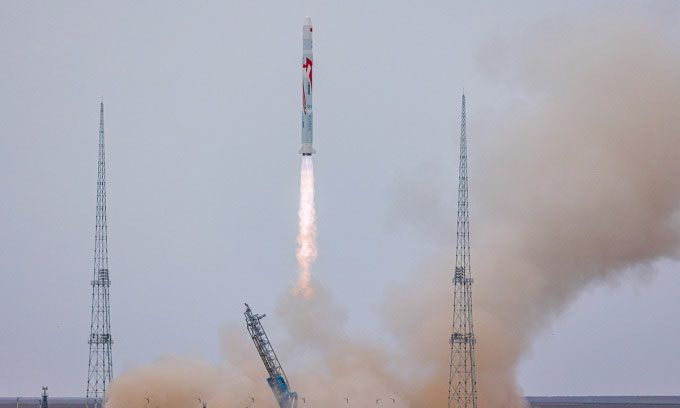The year 2023 witnessed numerous significant rocket and spacecraft launches, including the first spacecraft to land near the Moon’s south pole.
The First Spacecraft from Another Planet to Orbit the Moon

The Ariane 5 rocket launches the JUICE spacecraft from the launch pad. (Photo: ESA).
The Ariane 5 rocket launched the Jupiter Icy Moons Explorer (JUICE) from Kourou, French Guiana, at 19:14 on April 14 (Hanoi time). Developed by the European Space Agency (ESA), JUICE focuses on studying three of Jupiter’s moons: Ganymede, Europa, and Callisto. The mission aims to confirm the presence of subsurface oceans containing liquid water on these moons while searching for conditions and components essential for life.
JUICE is equipped with 10 scientific instruments and is expected to take approximately 8 years to reach Jupiter. Around 500 to 1,000 scientists are involved in the mission alongside their counterparts in the United States and Japan. This marks ESA’s first journey to the outer regions of the Solar System, highlighting a significant milestone in Europe’s space exploration efforts. The spacecraft will also provide valuable information for future lunar exploration missions.
The World’s First Methane Rocket Launched into Orbit

The Zhuque-2 rocket lifts off on July 12. (Photo: VCG).
The Zhuque-2 rocket from the Chinese company Landspace lifted off from the Jiuquan Satellite Launch Center in the Gobi Desert at 08:00 on July 12 (Hanoi time). The United States Space Force confirmed China’s announcement regarding the Zhuque-2 rocket reaching orbit.
Zhuque-2 also became the world’s first methane-fueled rocket to successfully launch three satellites: Honghu, Honghu 2, and TY-33 into orbit as planned.
Although methane is a greenhouse gas, it is cleaner and more environmentally friendly than the standard RP-1 (kerosene) used by many rockets. Methane burns cleaner than carbon-based fuels, which extends engine life, making it more suitable for reusable rockets. Several American companies are also researching methane-fueled rockets, including SpaceX with its Starship launch system and Blue Origin with its New Glenn rocket.
The Zhuque-2 rocket is 49.5 meters long, has a diameter of 3.35 meters, and a launch weight of 220 tons excluding payload. The success of this rocket model opens a new era for methane in the satellite and commercial spacecraft launch industry.
India’s spacecraft lands near the Moon’s south pole
Moment the Indian lander touches down on the Moon’s surface. (Video: ISRO)
The Vikram lander of India’s Chandrayaan-3 mission successfully landed in the vicinity of the Moon’s south pole at 19:34 on August 23 (Hanoi time). This achievement made India the fourth country in the world to land on the Moon’s surface, following the Soviet Union, the United States, and China, marking India’s emergence as a new space power.
Shortly after Vikram landed, the Pragyan rover began to descend from the lander. The rover completed its mission, which included a lunar walk, confirming the presence of sulfur and detecting several other elements. It switched to sleep mode for nearly two weeks after the impressive landing.
India also made history as the first country to land a spacecraft near the Moon’s south pole. This achievement is particularly notable given that Russia’s Luna 25 spacecraft had also aimed to land in the same region in August but ultimately failed.
The Moon’s south pole is extremely challenging to land on but is believed to contain the most water. Frozen water in the dark craters here could be converted into drinking water for future astronauts. Countries are also paying attention to this resource as water can be split into oxygen and hydrogen, used as rocket fuel and for producing breathable oxygen.
NASA Successfully Returns Asteroid Samples to Earth

The asteroid sample capsule from Bennu lands intact in the Utah desert. (Photo: Keegan Barber)
The OSIRIS-Rex spacecraft from NASA was launched into space on September 8, 2016, and reached the asteroid Bennu in December 2018. At that time, Bennu was the smallest celestial body with a spacecraft orbiting it. On September 24, 2023, after a journey of 6.2 billion kilometers through space, OSIRIS-Rex landed in the Utah desert, USA. NASA and the US Air Force successfully retrieved the capsule containing asteroid samples collected by the OSIRIS-Rex spacecraft in 2020. This mission marks NASA’s first successful collection of asteroid samples.
The OSIRIS-Rex sample capsule contains 250 grams of rock and other materials from Bennu. The samples will be distributed to various institutes and space agencies around the world. Research on these materials could help answer critical questions scientists have about the origins of life on Earth and the early Solar System.
NASA Launches Spacecraft to the 10 Quintillion Dollar Asteroid
The Psyche spacecraft lifts off on the Falcon Heavy rocket. (Video: Space)
The NASA Psyche spacecraft launched on the SpaceX Falcon Heavy rocket from Kennedy Space Center on October 13, heading towards the metal-rich asteroid 16 Psyche. The spacecraft is expected to arrive at 16 Psyche in July 2029. This marks the first official interplanetary mission of the Falcon Heavy and also the first mission NASA has launched using this rocket model.
Among the nine metal-rich asteroids in the Solar System, 16 Psyche is one of the largest, measuring 280 km in width and 232 km in length. Discovered in 1852, it is considered one of the most intriguing objects in the main asteroid belt that scientists have only studied from afar. This asteroid has garnered significant interest due to its surface primarily composed of nickel and iron, estimated to be worth up to 10 quintillion dollars.
16 Psyche is believed to be the core of an ancient protoplanet. Researchers hope that examining this metallic body can provide insights into the processes that formed rocky planets in the Solar System, including Mercury, Venus, Earth, and Mars. Even if it is not the core of a protoplanet, 16 Psyche remains fascinating to researchers as it belongs to the category of primitive bodies in the Solar System.



















































